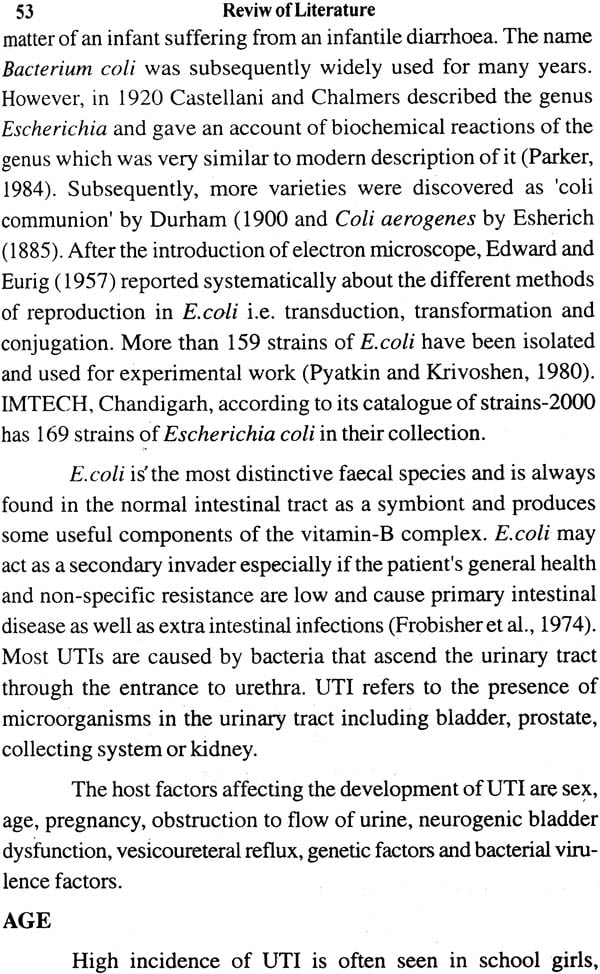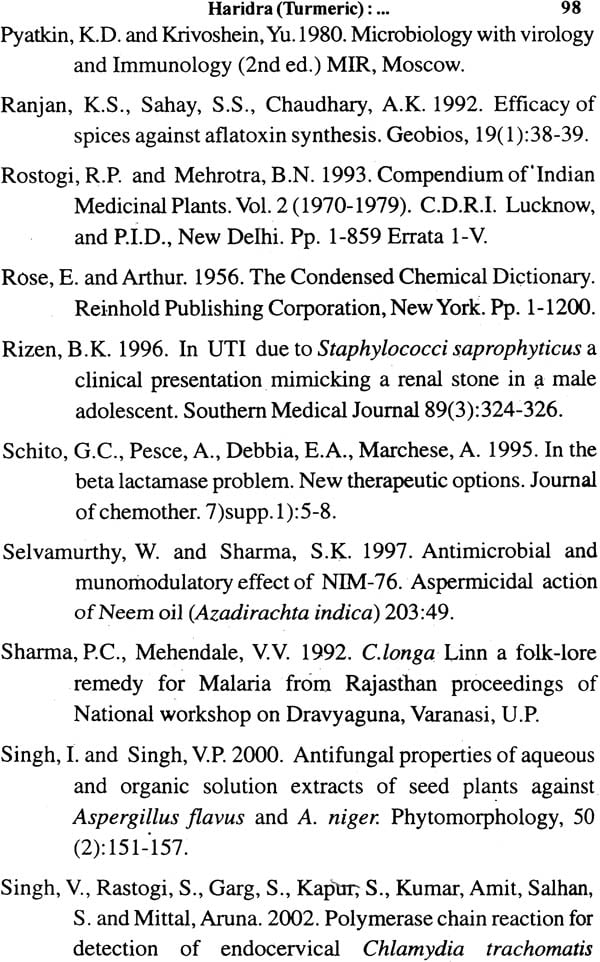![Haridra [Turmeric]: Antibacterial Potential](http://occultnthings.com/cdn/shop/products/haridra_turmeric_antibacterial_potential_idf310_{width}x.jpg?v=1678104674)
Haridra [Turmeric]: Antibacterial Potential
Book Specification
| Item Code: | IDF310 |
| Author: | Purshotam kaushik |
| Publisher: | Chaukhamba Sanskrit Pratishthan |
| Language: | English |
| Edition: | 2003 |
| ISBN: | 8170800846 |
| Pages: | 124 (Coloured Illus: 16) |
| Cover: | Hardcover |
| Other Details | 8.8" X 5.5" |
| Weight | 290 gm |
Book Description
From the Back of the Book:
Turmeric, the magic medicine of ancient India is as relevant and useful today as it was during the days of Acharya Charak, the great physician of ancient India. It is used as a colouring agent in pharmacy confectionary and food industry. The turmeric because of some of its strong antioxidants compounds inhabits the synthesis of aflatoxins. The volatile oil of turmeric is effective in bronchial asthma.
The research monograph covers history of turmeric, trade in turmeric, synonyms in Sanskrit, turmeric in Sanskrit literature, botanical, description, chemical constituents, biological activity, estimation of curcumin, curing of turmeric, parts used, medicinal use, folklore medicine, as a raw drug sold in the market, preparations, turmeric creams, patenting or intellectual. Property rights, cultivation of turmeric, micro propagation of turmeric, mechanism of action of antimicrobial, drugs, range of antibiotic action, review of literature, bacteriology of test organisms, materials and methods, interpretation of results, summary and literature cited.
The monograph will be useful for the researchers, teachers and students of botany, microbiology, pharmacy, ayurveda home science, agricultural sciences and those interested medicine.
About the Author:
Dr. PURSHOTAM KAUSHIK, is currently professor of Botany and Microbiology, Gurukul Kangri University, Hardwar and he has also headed the department for two terms. Prof. Kaushik did his doctorate from Punjab University, Chandigarh. He has professed teaching and research at Punjab University, and Guru Nanak Dev University, Amritsar. He has bean the principal investigator of Ministry of Environment and Forests, Govt. of India, project on 'Environment Biology of the Himalayan Orchids' and U.G.C. project on Lectins.
Prof. Kaushik has published over 70 research papers and has authored two text books on microbiology and original research monographs on orchids, medicinal plants and raw drugs.
Prof. Kaushik, is currently President of Academy of plant sciences. He has visited Universities of London, Cambridge and R.B.G., kew (United Kingdom) and institute Pasteur, Paris (France).
Prof. Kaushik has been associated with designing and starting M.Sc. (Microbiology) Courses at Gurukul Kangri University, Hardwar, since very inception of the courses, and possesses a teaching and research experience of three decades.
Turmeric, Curcuma longa, is one among 42 species of the genus Curcuma grown commercially because of its economic importance. India is not only the largest producer but also a leading exporter of turmeric in the world. Turmeric rhizomes have been used as a spice, colouring agent and in preparation of Ayurvedic medicines in India since antiquity. Known to be the magic medicine of ancient India, still it is as relevant and useful as was during the time of Acharya Charak, the great physician of the country. Recent reports from the USA demonstrated the anti- cancer effects of curcumin, the active compound of turmeric. The great traveller Maroco Polo describes turmeric as a. vegetable having all properties of true saffron. Hence, it can be called poor man's saffron.
I appreciate the efforts made by Dr. Purshotam Kaushik in writing the research monograph, which covers almost all important aspects of turmeric. I consider it to be a valuable addition to the books and monographs already authored by Dr. Kaushik. I am sure, this publication will help in widening the knowledge of researchers and students of biological and biomedical sciences engaged in research and development of turmeric.
In case of an accident, thrust, blow or injury the most common prescription of an Indian layman is to give a glass of warm milk mixed with a spoon of powdered turmeric. The use of turmeric as a colouring material, in therapy of various types of ailments and applying at surgical cut of placenta at the time of birth was known long back to the Indian masses. The multi- application of turmeric made it an essential component of marriage ceremonies and some other rituals.
The curcumin which is one of the major chemical constituents, is a potent oxidant and has been considered to inhibit certain types of cancer to some extent. Studies on smokers have revealed that turmeric given in daily dose from a fortnight to a month can decrease mutagens in urine. Its antitumour effects in animals treated with potent carcinogens, have been reported recently. The pharmacological properties of curcumin include anti -inflammatory antioxidant, inhibition of platelet aggregation, local spasmolytic hepatoprotective and chloretic properties.
The opportunistic pathogen Escherichia coli was isolated from urinary tract infection (U.T.I.) patients and its biochemical characterization was done. The aqueous decoction and alcoholic extract of turmeric were tested against the aforesaid test organism in vitro. The inhibition caused by turmeric was compared with standard antibiotics. The study revealed efficacy of turmeric.
This treatise brings a discussion on patenting and should motivate Indian Researchers and our Government agencies to get our valuable ancient heritage patented rather than to waste money in expensive foreign courts to safeguard our rights.
This research monograph is a novel attempt of this type and will be useful for the students and teachers of Universities and colleges who want to study botany, microbiology, medicine and pharmaceutical sciences. It will also be of use for agricultural scientists interested in cultivation of turmeric and policy makers associated with production of spices and condiments and their products.
| Citation of Acharya Charaka | 2 |
| Foreword | 3 |
| Preface | 4-5 |
| Acknowledgement | 6-7 |
| Contents | 8 |
| Introduction | 9-50 |
| Review of Literature | 51-60 |
| Bacteriology of Test Organisms | 61-63 |
| Material and Methods | 64-79 |
| Observations and Results | 80-83 |
| Discussion | 84-86 |
| Summary | 87 |
| Literature Cited | 88-101 |
| Index | 103-108 |
| Figures | 109-124 |













